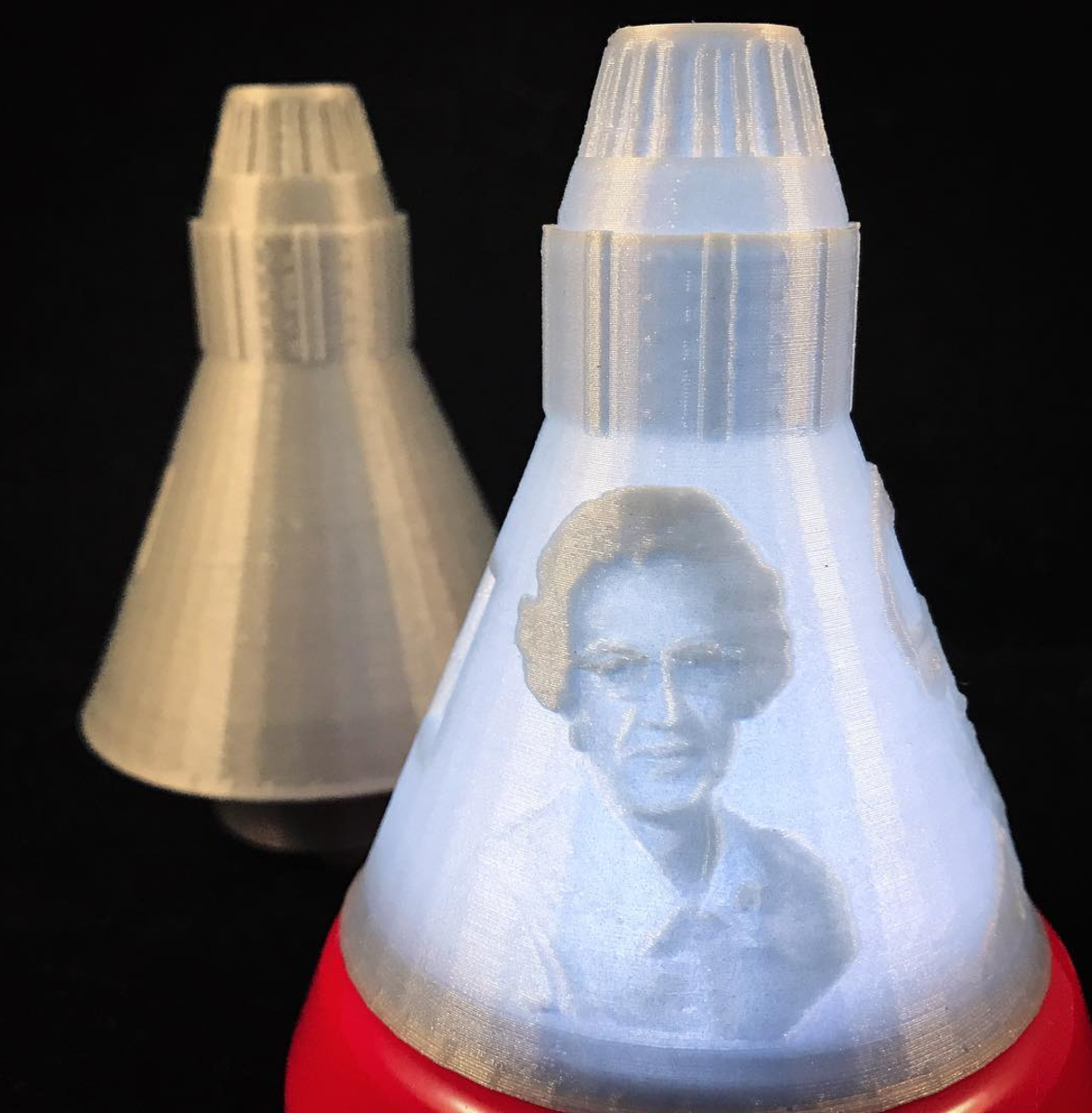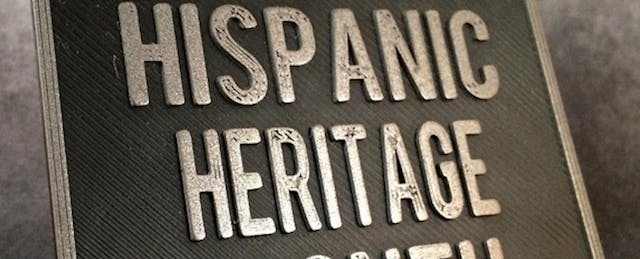For years, school leaders in Loudoun County, Virginia “had been talking about a one-to-one technology initiative,” says Josh Ajima, instructional facilitator for technology at Dominion High School and Loudoun Academy of Science. “But it kept getting pushed back and back. It had been five or six years that they had been talking about, ‘the next big thing.’”
It turned out that one-to-one technology was not the next big thing. Ajima was. Tired of waiting for his school to acquire a 3D printer, he took $500 of his own money and bought one. That investment unleashed a dynamo who has become a pre-eminent evangelist for digital fabrication and Making in the classroom. And it’s his work in the classroom that has led him to inspire educators and create communities of Makers around the world.
Last winter, for example, Ajima wanted to create a 3D printing project that would help his students celebrate Black History Month. He was motivated, in part, by the September opening of the National Museum of African American History and Culture on the Washington Mall, just 30 minutes away from Dominion High. As the district’s “3D printer guy,” he had decided it would be cool to fabricate something that honored the three African American women—Katherine Johnson, Dorothy Vaughan, and Mary Jackson—who are the focus of the book and film Hidden Figures.
“I’m driving along over winter vacation thinking, 'how do you represent a mathematician?'” he recalls. “This brainstorming is the same process the students are going through. I’m thinking, an adding machine or a rocket or a trajectory?” Then Ajima thought about a lithophane, an artwork etched on porcelain that is largely invisible until it’s backlit. The process is nearly 200 years old but has recently been adapted for 3D printing and become widely used.
“Somehow, it just clicked,” Ajima says. “You create something that looks like a regular space capsule and then you put a light underneath it and, boom, these hidden figures literally pop up.” The Friendship 7 models that Ajima 3D-printed with portraits of the three women are a brilliant mash-up of the concrete and the metaphorical. The designs have already been downloaded thousands of times.

The Hidden Figures models had their origins in one of Ajima’s most meaningful projects. He wanted to 3D print something for the school library’s Martin Luther King Jr. Day display, and he went online to find a design. “There’s a 3D printing repository called Thingiverse,” Ajima says. “They literally have millions of designs.” He “searched for Martin Luther King and found . . . zero things,” he says. “The next month I searched for Black History Month and I found . . . zero things. A year later, Women’s History Month . . . zero things.”
Ajima points out that if you search the site “for Yoda, for example, you’re going to find hundreds of designs for Yoda. But if you search for designs related to identity, history, or culture,” he says, you find nothing. To Ajima that was a challenge, one that he enlisted his students—and the larger educator community—to tackle.
Dominion has about 225 students who are English language learners (ELL), many of them from El Salvador, Honduras and Guatemala. So when National Hispanic Heritage Month rolled around, says Ajima, “I searched Thingiverse for ‘Hispanic’ and ‘Latino’ and ‘Latina’ and I found . . . zero things. Rather than see this as a problem, however, I saw it as an opportunity.” Ajima realized that if he wanted digital fabrication designs that celebrated his students’ backgrounds, they’d have to create them.
Ajima launched the National Hispanic Heritage Month Maker Challenge, calling on ELL, Art, and Spanish educators and students around the country to create digitally fabricated art pieces and share them. At Dominion, “I had students take Sharpies and draw designs on paper (2D),” he says. They 3D modeled the designs using Tinkercad, printed them and then shared them online. The designs included a necklace pendant in the shape of El Salvador and Ajima’s favorite, a sticker that read “100% Guanaco” (Guanaco is a nickname for Salvadorans).
These students don’t often get “to talk about themselves and their heritage and culture and who they are,” says Ajima. “That was something that made this pretty powerful.”

At the heart of the Hispanic heritage project was Ajima’s insistent belief in the power and necessity of sharing, of communicating what you’ve done with others. “For me,” Ajima says, “the question is how do we take these things and create communities of Making?”
Ajima has created one such community with his blog, DesignMakeTeach, where he inspires teachers with tips, tutorials and lessons about integrating digital fabrication into classrooms. He calls the blog part of his "personal professional development and a model of the design, make, share process."
He also actively engages in other Maker educator communities, where he supports and explores the educational potential of Maker-based learning. At Stanford University, Ajima is a part of a FabLearn Fellow cohort of educators who like him are committed to sharing Making ideas, best practices and resources—on a global scale; as a Fellow, he is writing a chapter for the next edition of Meaningful Making: Projects and Inspirations for Fab Labs and Makerspaces. Formerly a member of Make magazine’s digital fabrication review team, he is now contributing to a YouTube channel that will be for Maker educators by Maker educators. By engaging in these communities, Ajima models the design, make, share process.

One of the things Ajima has shared widely is his belief that any teaching space can become a place where Making is woven into learning. If you limit yourself to one dedicated, physical Makerspace, he says, “you can only use it for one class at a time.” Instead, he encourages teachers to devise ways to bring Making into any classroom.
At Dominion, says Ajima, we “created Maker carts that roll out to the classroom. We can do these for about $500 each. That’s totally scalable. Then we buy tools that can go on the cart like a 3D printer or a 3D scan or a vinyl cutter.” This mobile Makerspace idea won Dominion $50,000 in cash and prizes from the U.S. Department of Education’s 2016 CTE Makeover Challenge, which named the school one of 10 winners nationwide.
Ajima doesn’t expect other educators to wait around until Uncle Sam writes them a big fat check before they begin exploring digital fabrication. To help them launch Making efforts in their schools, he created the Makerspace Starter Kit; includes a host of helpful links to sites such as Tinkercad and Instructables.
In his day to day work, Ajima continues to support students at Dominion while also inspiring educators everywhere to embrace digital fabrication and Making in their classrooms. In doing so, Ajima has produced something that is both more inclusive and more expansive than Loudoun County’s long awaited one-to-one technology: one-to-many.
Resources for National Hispanic Heritage Month — Sept. 15 - Oct. 15
Jeff Ajima shares his favorite teaching resources for using 3D design to celebrate Hispanic and Latino American heritage and culture:
| DIWO | Aprendiendo a diseñar en Tinkercad |
| Tinkercad | Learning to design |
| Inkscape | Una potente herramienta libre de diseño |
| Making Starts Here | Autodesk’s comprehensive guide |
| Smithsonian Education | Hispanic heritage teaching resources |
| Smithsonian Latino Center | Supporting research, education, digital content and more |
| PBS | The Latino Americans documentary series |



